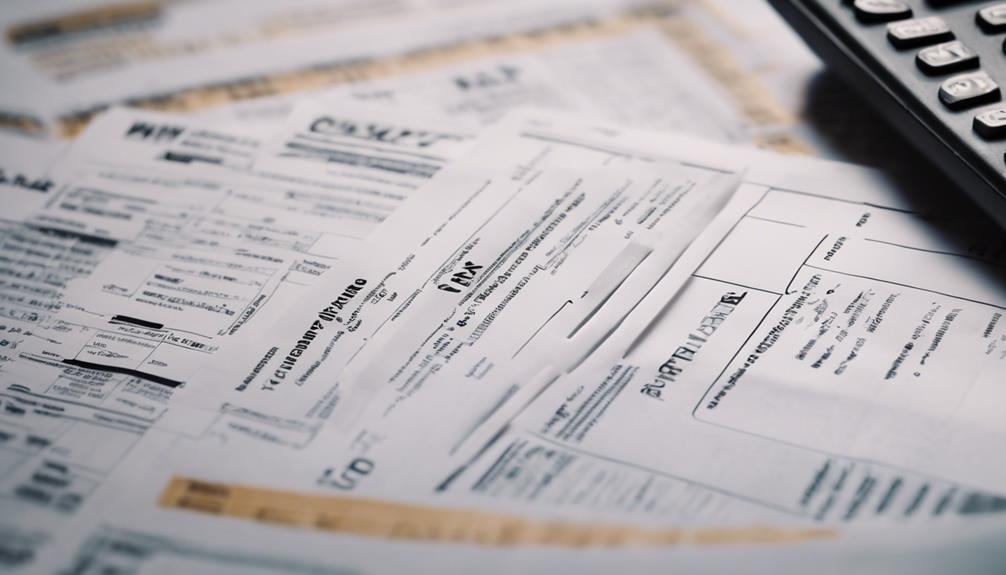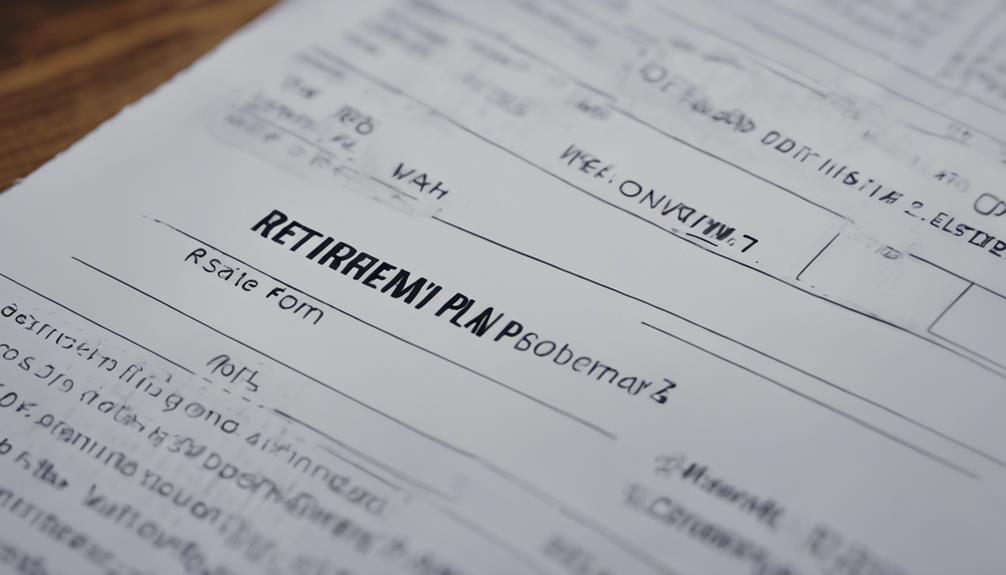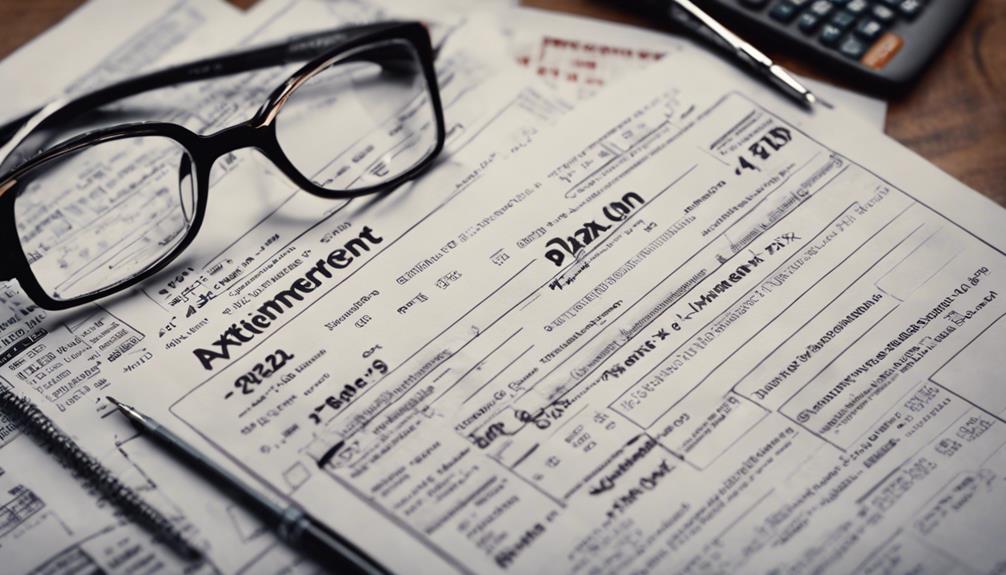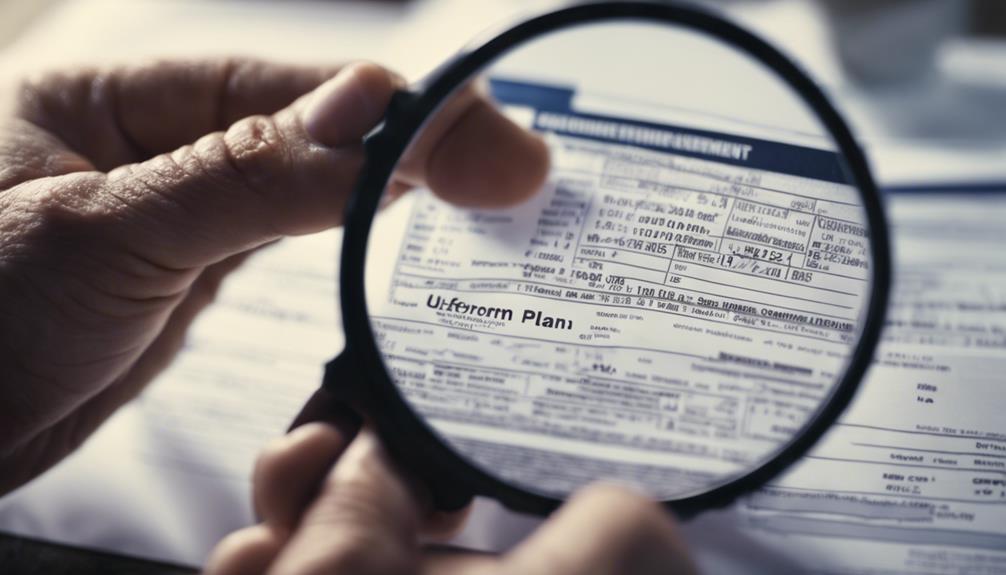The ‘Retirement Plan’ on your W-2 form indicates whether you are actively participating in an employer-sponsored retirement savings program. It is important for determining tax implications, especially for traditional IRA contributions. Different codes on your W-2 also indicate specific retirement plan contributions, such as 401(k) and 403(b). It is crucial to accurately mark this box and understand the details for proper tax filing. Understanding this information can help you make informed decisions regarding your retirement savings and tax benefits. Continue to explore to learn more about the different types of retirement plans, contribution limits, and employer contributions for effective financial planning.
Key Takeaways
- Box 13 on W-2 indicates retirement plan participation status.
- Different Box 12 codes specify retirement plan contributions.
- Checking the retirement plan box affects tax implications.
- Review W-2 for accurate reporting of retirement contributions.
- Understanding W-2 retirement plan details aids tax planning.
Definition of Retirement Plan on W2
When reviewing your W-2 form, understanding the retirement plan designation in Box 13 is essential for determining your participation status in a retirement plan. This small box holds significant implications for your financial future. By checking this box, you can quickly discern whether you're an active participant in a retirement plan. The codes in Box 12 further specify the type of retirement plan contributions made. This information is vital as it affects tax deductions, especially for traditional IRA contributions.
Knowing your status as an active participant is key to planning for retirement. Defined contribution or defined benefit plans determine this status. Whether you're contributing to a 401(k), pension, or another retirement plan, the designation in Box 13 gives you a snapshot of where you stand. Understanding the nuances of this box empowers you to make informed decisions about your financial well-being. So, next time you glance at your W-2, pay close attention to the retirement plan box—it holds the key to your retirement readiness.
Types of Retirement Plans Eligible

When it comes to retirement plans eligible for your W-2, common options include:
- 401(k)
- 403(b)
- Defined benefit plans
- SIMPLE IRAs
These plans have specific contribution limits that determine how much you can save annually.
Understanding the type of retirement plan you have can help you make informed decisions about your savings and tax implications.
Common Retirement Plans
Common retirement plans eligible for individuals include options such as 401(k), 403(b), 457(b), and defined benefit plans. A 401(k) is a popular choice where employees can contribute a portion of their salary, sometimes matched by the employer.
A 403(b) is similar to a 401(k) but is typically offered to employees of public schools and tax-exempt organizations. A 457(b) plan is available to state and local government employees.
Defined benefit plans, also known as pension plans, provide retirees with a fixed payment based on salary and years of service. These plans offer tax advantages, aiding individuals in saving for retirement while reducing taxable income. Understanding the differences between these retirement plans can help in making informed financial decisions.
Contribution Limits
Moving from an overview of common retirement plans, we now shift our focus to the contribution limits associated with different types of retirement plans eligible for individuals. Contribution limits vary depending on the type of retirement account, such as 401(k), 403(b), and IRA plans. Each plan has its own set limits regulated by the IRS, with provisions for catch-up contributions for those over 50 years old. Understanding these limits is essential for maximizing retirement savings and tax benefits. Below is a table outlining the contribution limits for each type of retirement plan:
| Retirement Plan | Annual Contribution Limit | Catch-Up Contributions Available |
|---|---|---|
| 401(k) | IRS set limits | Yes, for individuals over 50 |
| IRA | Separate from employer-sponsored plans | Yes, for individuals over 50 |
| 403(b) | Different from 401(k) plans | Yes, with unique provisions |
Tax Implications of W2 Retirement Plan
Understanding the tax implications of the retirement plan indicated on your W-2 can greatly impact your annual tax obligations. Checking the retirement plan box signifies active participation, influencing tax filing and deductions for the year.
It's important to verify if contributions are pre-tax or post-tax to guarantee accurate reporting. Consulting a tax professional can offer guidance on maneuvering the implications of this indicator on your taxes.
Accurate reporting on tax forms is vital to avoid potential discrepancies or penalties. Being mindful of how your retirement plan status affects your taxes can help you make informed decisions and plan for any potential tax liabilities.
Stay informed and proactive when it comes to understanding the tax implications of your W-2 retirement plan to effectively manage your tax responsibilities.
Understanding Employer Contributions

Employers contribute to retirement plans by reporting specific codes like D, E, F, G, or H on Form W-2 in Box 12. These codes indicate the type of contributions made towards your retirement. For instance, code D signifies elective deferrals under a 401(k) plan, while code E represents salary deferred under a 403(b) agreement.
Understanding these codes is important as they impact your tax deductions and provide insight into the retirement plans you're part of. By checking Box 13 on Form W-2, you can confirm active participation in a retirement plan, influencing your tax filings and potential deductions.
Being aware of the employer contributions outlined in your Form W-2 helps you comprehend the benefits you're receiving as part of your retirement plan. It's vital to stay informed about these details to make the most out of your retirement savings and tax advantages.
Individual Contribution Limits

When it comes to retirement plans, understanding individual contribution limits is essential. These limits dictate the maximum amount one can contribute, like $19,500 for 401(k) plans in 2021.
Additionally, individuals aged 50 and older can make catch-up contributions, allowing them to save more, such as an extra $6,500 for 401(k) plans in 2021.
Contribution Maximum Amounts
The maximum individual contribution limit for 401(k), 403(b), and most 457 plans in 2021 is $19,500, as set by the IRS. To provide a clear overview, below is a table detailing the contribution maximum amounts for various retirement plans:
| Retirement Plan | Contribution Limit |
|---|---|
| 401(k) | $19,500 |
| 403(b) | $19,500 |
| 457 | $19,500 |
| SIMPLE 401(k) | $13,500 |
| Traditional/Roth IRA | $6,000 |
These limits are important for planning your retirement savings strategy effectively. Keep in mind that these figures are subject to change annually based on IRS regulations. Plan your contributions wisely to make the most of your retirement savings potential.
Catch-Up Contributions
Boosting retirement savings for individuals aged 50 and above, catch-up contributions allow for additional funds to be contributed to retirement accounts.
- Catch-up contributions can help bridge the gap in retirement savings for individuals who may have fallen behind.
- These extra contributions provide a financial cushion for those nearing retirement age.
- Utilizing catch-up contributions empowers older individuals to secure a more stable financial future in retirement.
Benefits of Contributing to a Retirement Plan

Contributing to a retirement plan offers significant tax benefits and long-term financial advantages. When you contribute to a retirement plan, you can potentially reduce your taxable income, leading to a lower tax bill. Additionally, the money you put into your retirement account can grow tax-deferred, allowing your savings to grow faster over time through compounding.
Many employers sweeten the deal by offering matching contributions, essentially giving you free money for saving towards your future. By saving in a retirement plan, you aren't only building a nest egg for your retirement but also ensuring financial security down the road.
Moreover, retirement plan contributions may qualify for tax deductions, providing an extra layer of tax benefits for your savings. Overall, contributing to a retirement plan is a smart financial move that can help you secure a more stable and comfortable future.
How W2 Reporting Affects Taxes

When it comes to your taxes, the way your retirement contributions are reported on your W-2 can have significant implications. These can affect deductions and eligibility for certain tax benefits.
Understanding how your retirement plan status is reported can help you navigate tax season more effectively.
Tax Implications of W2
Understanding how the information reported on your W-2 impacts your taxes is essential for maximizing deductions and managing retirement contributions effectively. When it comes to tax implications of your W-2, consider the following:
- Checking the retirement plan box on your W-2 signifies active participation in a retirement plan, influencing tax considerations.
- The retirement plan indicator in Box 13 aids in determining tax implications for traditional IRA contributions, affecting taxable income.
- Different codes in Box 12 of the W-2 denote specific types of retirement plan contributions, such as 401(k) elective deferrals (Code D) and 403(b) contributions (Code E), which can impact tax liabilities.
Reporting Retirement Contributions
Verifying whether retirement contributions are made on a pre-tax or post-tax basis is vital for accurately reporting them on your tax forms, as this information directly impacts your taxable income and deductions.
Understanding how your retirement benefits are structured can influence the taxes you owe or the refund you receive. On Form W-2, the box indicating participation in a retirement plan highlights the significance of these contributions.
Consulting a tax professional can offer valuable guidance on handling these contributions when filing your taxes. Precise reporting of retirement contributions on tax forms is essential to prevent discrepancies or penalties.
Being informed about the tax implications of your retirement plan ensures a smoother tax-filing experience and maximizes potential savings.
Importance of Reviewing W2 for Accuracy

Reviewing your W2 for accuracy is essential to guarantee proper documentation of your retirement plan contributions. Here are three key reasons why accuracy in reviewing your W2 is important:
- Tax Filing Impact: Ensuring the retirement plan indicator in Box 13 is correctly marked on your W-2 is crucial for accurate tax filing and potential deductions.
- Verification of Contribution Type: Confirming if your contributions are pre-tax or post-tax can have a significant impact on how you report on your tax forms.
- Professional Guidance: Consulting with a tax professional can provide valuable insights into understanding the implications of the retirement plan indicator on your W2.
Retirement Plan Options Beyond W2 Reporting

Exploring additional retirement savings avenues beyond W2 reporting broadens financial planning horizons for individuals seeking to maximize their long-term investment strategies.
Beyond what's reflected on your W2, there are various retirement plan options that individuals can explore for the upcoming tax year. Understanding different types of retirement accounts, such as Traditional IRAs, Roth IRAs, or SEP IRAs, can provide additional opportunities to save for retirement while potentially reducing your taxable income.
Exploring these avenues allows for a more diversified approach to retirement planning, catering to individual preferences and financial goals.
Additionally, looking into employer-sponsored plans like 401(k)s or 403(b)s can offer further tax advantages and potential employer contributions, enhancing your overall retirement savings strategy.
Planning for Retirement With W2 Information

When contemplating retirement planning with W2 information, understanding the implications of active participation in an employer-sponsored retirement plan is vital. It's important to grasp how your contributions or forfeitures impact your retirement savings strategy.
Here are three essential points to ponder:
- Review your W-2 each year to confirm accurate reporting of retirement plan participation.
- Determine if contributions are made on a pre-tax or post-tax basis for proper tax filing.
- Seek guidance from a tax professional to maximize retirement savings and understand the tax implications.
Frequently Asked Questions
What Does Box 14 of W-2 Say About Retirement?
Reviewing your W-2's Box 14 for details about retirement contributions or plans can provide valuable information about your employer's retirement benefits. Take the time to check this section for any specifics related to retirement offered by your company.
Understanding how your employer handles retirement savings is crucial.
What Box on W-2 Shows Retirement Contributions?
Box 12 on the W-2 is where retirement contributions shine. This box is like a treasure trove, revealing the valuable pension amounts we've stashed away. It's a vital spot for tracking our retirement savings growth.
How Do I Know if I Have a Retirement Plan?
If we want to determine if we've a retirement plan, we should check Box 13 on our W-2. This box shows our active participation in a retirement plan.
By looking at this indicator, we can understand our eligibility for different retirement plans and the implications for tax deductions.
Additionally, specific codes in Box 12 of the W-2 reveal details about the types of retirement plan contributions we've made.
This information can give us insights into our retirement savings and tax situation.
What Is Considered Retirement Plan for Tax Purposes?
We consider a retirement plan for tax purposes as any qualified arrangement allowing us to save for our golden years with tax advantages. It's like a financial gift from our present selves to our future selves, protected from the taxman until we're ready to enjoy it.
These plans can include 401(k)s, IRAs, pensions, and more, helping us build a nest egg while reducing our current tax burden.
How Does Your Pension Tie into Your W2 Retirement Plan?
Your pension and retirement planning are interconnected with your W2 retirement plan. Your pension contributions are often reflected in your W2 form, indicating the amount of income you set aside for retirement. Understanding how your pension ties into your W2 retirement plan is crucial for effective financial planning.
Conclusion
To sum up, grasping the retirement plan information on your W2 is vital for planning your financial future.
While it may seem daunting at first, reviewing your W2 can offer valuable insights into your retirement savings.
So, don't underestimate this significant detail on your tax documents – it could make a big difference in your retirement years down the road.










